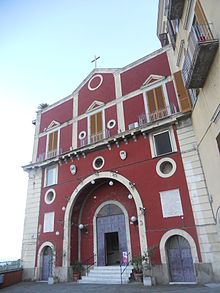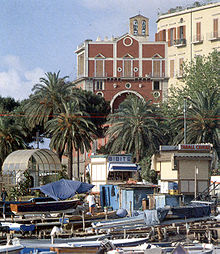| Church of Holy Mary of Childbirth in Mergellina | |
|---|---|
| Chiesa di Santa Maria del Parto a Mergellina | |
 The façade of Santa Maria del Parto a Mergellina. The façade of Santa Maria del Parto a Mergellina. | |
| 40°49′30″N 14°13′13″E / 40.824912°N 14.220245°E / 40.824912; 14.220245 | |
| Location | Chiaia Naples Province of Naples, Campania |
| Country | Italy |
| Denomination | Roman Catholic |
| History | |
| Status | Active |
| Architecture | |
| Architectural type | Church |
| Style | Baroque architecture |
| Groundbreaking | 1504 |
| Completed | 1529 |
| Administration | |
| Diocese | Roman Catholic Archdiocese of Naples |
Santa Maria del Parto a Mergellina (Holy Mary of Childbirth in Mergellina) is a church located in the quartiere of Chiaia in Naples, Italy. The church is peculiarly perched on top of a private building and accessed by a stairway, placed behind a restaurant located in piazza Mergellina.
History
The church was founded by the poet Jacopo Sannazaro on land donated to him by King Frederick I of Aragon in 1497. In 1526, Sannazaro authored a poem in Latin hexameter titled De partus Virginis (Childbirth of the Virgin) that helped give the church its name. The church was completed shortly before the poet died in 1530, it was donated to the monks of Santa Maria dei Servi. Sannazzaro's tomb sits behind the altar. The lower church was originally dedicated to the Vergine del Parto (Virgin of Childbirth) and later converted into a crypt. The funeral chapel was originally dedicated to San Nazario and subsequently transformed into the church of "Santa Maria del Parto". In 1886, the church was declared a national monument and became the property of the State.

Art and architecture
The principal work in the church is the semi-pagan tomb of the poet, represented on the pedestal under the name of Actius Sincerus and being crowned by Fame in a fresco by Niccolò Rossi, a follower of Giordano. The statue, with its complex pagan iconography (1537), is set in the choir behind the altar and was built by the sculptors Bartolomeo Ammannati, Giovanni Angelo Montorsoli and Francesco Ferrucci, although initiated by Girolamo Santacroce Marble was purchased in 1537. The niche is inspired by the environment of Arcadia, also has depictions of Neptune with his trident, Pan and the nymph Syrinx, all in dancing and singing the praises of our poet, and a satyr which gazes in amazement. The arrangement is considered by some confused in composition and with exaggerated movements of the figures.
Statues of Apollo and Minerva flank the tomb, however, given their location in a church, their plinths are labeled David and Judith. An epitaph by the Venetian cardinal Pietro Bembo, secretary to Pope Leo X, at the tomb base, reads: From flower to sacred ashes, here lies the famous and sincere Sannazaro, near to Virgil in poetry as in sepulchre Virgil's tomb is found nearby in Naples.
The chapel contains paintings with arcadian and mythologic iconography. It also contains frescoes of the Meeting of Abraham and three angels; on the ceiling are painted 'Astronomy, Philosophy, Grammar, and Rhetoric (1699). In the entry arch, Putti spread flowers in a fresco by Giovan Bernardo Lama. The pavement (1561) was made by Fabrizio Manlio di Barletta
In the chapel near the presbytery, the oil painting of the Epiphany is attributed to Jan van Eyck; this painting, Vasari claimed, was the first oil canvas in Italy. Other significant works of the building are the two statues sculpted by brothers heirs of Jacopo and Sannazaro the youth figure with a book in hand, the worm-eaten (but restored) residues of the Nativity scene by Giovanni da Nola.
In the first chapel on the right of the altar is the image of St Michael Archangel spearing the throat of a serpentine Lucifer, commonly known as the Devil of Mergellina, traditionally believed to depict an infamous young Neapolitan woman who had tempted Diomede Carafa, then bishop of Ariano. St Michael defeats her in a victory over worldly temptation ("ella morta giace in ogni luogo e viva sta in ogni luogo" which translates to "she is dead everywhere, and is alive everywhere"
It is reported that the Spanish painter Jusepe de Ribera was buried here
-
 Main altar.
Main altar.
-
 Tomb of Jacopo Sannazaro, detail of Minerva statue, by Ammannati.
Tomb of Jacopo Sannazaro, detail of Minerva statue, by Ammannati.
References
- De partus Virginis
- The frame of the plinth still reads clearly: F (rater) I (annes) Ang (ELUS) Flo (rentinus) or (Dinis) S (ervorum) ago (ciebat).
- G. Campori, Biographical Memoirs of sculptors, architects, painters etc. native Carrara and other places in the province of Massa, Modena 1873, p. 317.
- In ancient Neapolitan guides of Sacred Naples, for example, that of Cesare d'Engenio Caracciolo (1623), he remembers the commission in 1521 to a Neapolitan sculptor medal, depicting Sannazaro graduate in law, and in reverse, the Nativity. So writes the academic Pietro Summonte in a 1524 letter to Marcantonio Michiel, the oldest written historical-artistic art document in Naples "rises yet another artist aged 22. Hyeronimo Santacroce, which what was first gold was transmuted to marble . Sannazaro he portrayed in the medal and made a marble Apollo. "
- Benedetto Croce, Stories and legends Neapolitan, Naples, Adelphi, 1999 (reprint).
- (parapharase) "two beautiful seated statues of Apollo and Minerva, but to mitigate the admixture of sacred and profane for a monument destined for a temple, not a garden, the two statues are renamed David and Judith". Achille de Lauzieres, in Description of the city of Naples and its surroundings, Stab. Tip. Gaetano Noble, 1855, Naples, p. 64.
- Benedetto di Falco,de Descrittione places ancients of Naples, Appresso Giovanni Battista Hats, 1589. The inscription reads:Da sacro cineri flores hic ille Maroni sincerus Musa proximus ut tumulo (Da' fiori alle sacre ceneri: qui giace quel famoso Sincero vicino a Marone Virgilio nella poesia come in sepolcro).
- It depicts a person in bas relief (cited by Niccolò Toppi in "Huomini illustri in lettere di Napoli"), holding a book above his head. The inscription recall that Sannazaro loved Mergellina so much, he wished to be conducted to this hill to die and be buried: FABRITIO MANLIO NOBILI BAROLITANO, MAGNAE SPEI JUVENI CAMILLUS PATER MUNUS LACRYMABILE POS. HIC ADEO MERGELLINAM ADAMAVIT, UT AD EAM, INFIRMUS FERRI, ET IN EA MORI AC SEPELIRI VOLUERIT ANNO MDLXI
- Scipione Volpicella, Principali edificii della città di Napoli, in Storia dei monumenti del Reame dell Due Sicilie, Volume II, part 1, Naples: Stamperia del Fibreno 1847, p. 662.
- Giuseppe Mormile, Descrittione dell'amenissimo distretto della città di Napoli, Napoli, Ad istanza di Pietro Antonio Sofia libraro, 1617, p.12. Si veda anche Benedetto Croce, Storie e leggende napoletane, cit.; Matilde Serao, Leggende napoletane, Modena, E. Sarasino, 1891.
- Cesare D'Engenio Caracciolo, Napoli sacra, Napoli, per Ottavio Beltrano, 1623, p. 665.
- "Dov'è finito il corpo dello Spagnoletto" - articolo con commenti dei lettori tratto dal Corriere del Mezzogiorno on line - www.corrieredelmezzogiorno.it
Bibliography
- Tanja Michalsky, Erlösung in Arkadien. Sannazaros Grabmal und die Resemantisierung antiker Ausdrucksformen, in: Benvenuto Cellini. Kunst und Kunsttheorie im 16. Jahrhundert, Alessandro Nova / Anna Schreurs (eds.), Köln 2003, p. 239-254.
- Napoli e dintorni, Touring club Italia, Touring Editore, 2001.
- Benedetto Croce, Storie e leggende napoletane, Napoli, Adelphi, 1999.
- Idem, La tomba di Jacobo Sannazzaro and the church di S. Maria del Parto, in "Napoli Nobilissima", I (1892), 5, p. 70.